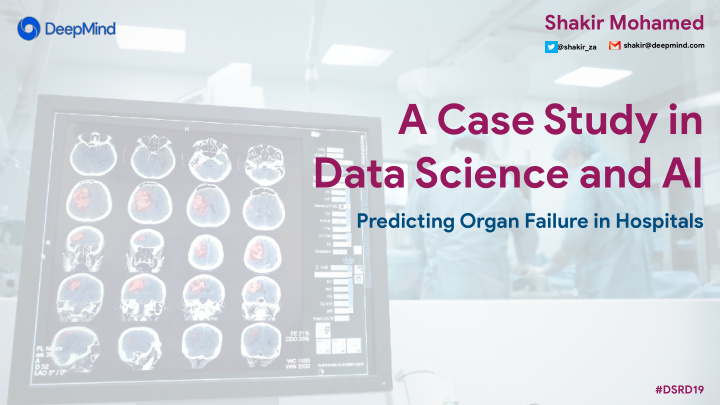



Shakir Mohamed shakir@deepmind.com @shakir_za A Case Study in Data Science and AI Predicting Organ Failure in Hospitals #DSRD19
Machine Learning in Healthcare Business Medical Electronic Operations Imaging Records Many areas for Machine Learning and Digital Platforms to play a role. #DSRD19 2 Shakir Mohamed
Triple Aims ‘The Triple Aim’ Health Affairs Don Berwick 1 2 3 Better clinical Enhance patient and Reduce outcomes clinician experience costs Systemic challenges Focus and on Unwarranted Care continues to > 10% of patients Staff burnout rates >50% of healthcare Intractable Failure to deliver illness at the variation exists be episodic vs experience harm in on the rise not evidence based increases in shared decision expense of across healthcare integrated hospitals healthcare costs making for patients prevention delivery #DSRD19 3 Shakir Mohamed
Detecting Deterioration • Millions of people die every year from diseases that could be prevented with earlier detection. • Worked with a hospital pa ru ner to look at AI for predicting patient deterioration. • Acute kidney injury (AKI), a condition where a patient’s kidney suddenly stops working properly. A fg ecting up to 1in 5 hospitalised patients in UK and US. Patient pathways Data from these processes are captured within an electronic health record. #DSRD19 4 Shakir Mohamed
Clinical Systems Patient Portals Analytics Engines FHIR API Open Standard Microbiology Emergency Maternity Operating Labs Radiology Demograp Outpatients Discharge Department hics Letters Theaters Characteristics DS/AI Interactions: • Unstructured • SWE and architects • Noisy • Security, privacy, law • Recorded di fg erently • Clinical requirements #DSRD19
Sequential representation Non-linear data #DSRD19
Data and Summarisation Data from a large hospital pa ru ner #DSRD19 8 Shakir Mohamed
Data Summarisation Characteristics Summary of dataset • Sequential representation • Sparse • Missing data • Included and excluded • Handling time, alignment DS/AI Interactions: • Impo ru ant research questions; arise from practical considerations. • Where do labels come from? • What predictions and metrics are impo ru ant to clinicians. 9 Shakir Mohamed
Future Prediction of AKI Model AKI Predicted Optional longer history Data used by the model 24h 48h 72h 48h history New entry Time 6h unknown 24h Outpatient events Admission Useful predictions are those that are accurate and continuously updated, given with su ffj cient time to act, provide context for decision Model on 700k features. Make predictions up to 48hrs ahead. #DSRD19 10 Shakir Mohamed
RNN cell RNN Main targets Auxillary targets + L L Fully-connected layer Main predictions Auxillary predictions Cumulative distribution function layer + Sum operation Loss function L Models RNN • Focus on strong baselines that were the current state of the a ru . Deep Model RNN • Gradient Boosted Trees • Logistic regression • New models using Deep Learning RNN • Non-linear models and interactions • Continuous integration of Deep Embedding information as they are received • Calibration, unce ru ainty Historical data Current step #DSRD19
�������������������������� ���������������������������� ������������������� �������� ���������������������� �������������������������� ������������������� ����������������������� ��������������� �������������������
A Clinically-applicable Approach to the Continuous Prediction of Future Acute Kidney Summary: • Make predictions of AKI up to 48hr ahead. • Provide a window for meaningful action. • For the most severe cases, can detect up to 90% of cases. Fu ru her considerations and limitations: Tomasev et al. (2019) • Early or late predictions and ale ru ing fatigue • Generalisation needed to wider steps of hospitals, patient populations. • Only a retrospective study. • Need prospective studies to evaluate real clinical-use. #DSRD19 13 Shakir Mohamed
Many Other Many Other Questions Sources of Questions, Pa ru ners and Data 14 Shakir Mohamed
Statistical Operations Estimation Hypothesis Inference and Learning Testing Comparison Summarisation Experimental Modelling Design Data Enumeration #DSRD19 15 Shakir Mohamed
Statistical Operations Inference Decision-making What we can What we can know about our data do with our data. Inference Comparison Summarisation Data Enumeration 16 Shakir Mohamed
Centrality of Inference A ru i fj cial Intelligence will be the Inference re fj ned instantiation of these statistical operations. Summarisation Comparison Data Enumeration The core questions of AI will be those of probabilistic inference #DSRD19 17 Shakir Mohamed
Principles to Products Advancing Climate and Fairness and Assistive Autonomous Healthcare Applications Science Energy Safety Technology systems World Objects and Reasoning Planning Explanation Rapid Learning Simulation Relations Information Prediction Uncertainty Information Gain Causality Probability Bayesian Hypothesis Estimation Principles Asymptotics Theory Analysis Testing Theory #DSRD19 18 Shakir Mohamed
Neutrality and Universality Neutrality Traps Universality • The Po ru ability Trap: solutions designed for one social context ‘A mono-cultural view of ethics may be inaccurate / do harm when applied to a di fg erent context. conceives itself as the only valid one. • The Formalism Trap: Failure to account for the full meaning of In order to avoid this kind of ethical chauvinism and colonialism it is social concepts such as fairness, and think they can be resolved necessary that transcultural ethics through mathematical formalisms. arise from an intercultural dialogue • The Ripple E fg ect Trap : Inse ru ing technology into an existing instead of thinking of itself as social system changes the behaviours and embedded values of universal without noticing its own the pre-existing system . cultural bias.’ Capurro, 2004 • The Solutionism Trap : Failure to recognise the possibility that the best solution to a problem may not involve technology. #DSRD19 19 Shakir Mohamed
20
Shakir Mohamed @shakir_za A Case Study in Data Science and AI Predicting Organ Failure in Hospitals #DSRD19
Recommend
More recommend